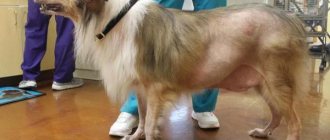Dogs, like humans, periodically need to be examined by doctors. If a person goes for an appointment at a city hospital, clinic or private medical center, dogs have only one way - to the veterinary clinic. There, specially trained doctors will examine the animal and take its biological fluids for laboratory analysis. Unfortunately, sometimes the tests are not all right. Owners often wonder, for example, why alkaline phosphatase in a dog’s blood is elevated and what this means for the pet. In this article we will discuss what exactly an increase in this enzyme indicates, and whether you should be afraid in advance.
Why is alkaline phosphatase elevated in a dog's blood?
Normal Alkaline Phosphatase Levels and Functions
Alkaline phosphatase is an enzyme that takes part in the metabolic processes of phosphoric acid. It serves as a knife, separating this acid from various organic compounds. In this way, an extremely important element for the proper functioning of the biorobot, phosphorus, moves through the body.
Phosphatase transports phosphorus throughout the dog’s body
Alkaline phosphatase accumulates to a greater extent in the following segments of the dog’s body:
- animal skeletal tissues;
- the inner mucous layer of the dog's intestines;
- in the tissues of the placenta;
- inside the mammary glands at the time when the whelped bitch feeds her babies.
Veterinary medicine determines the normal levels of alkaline phosphatase contained in the body of a healthy dog:
- Thus, in an adult animal it can be up to 100 units per liter;
- in growing puppies, the required figure may increase slightly due to the fact that at their age there is active growth of bone tissue.
Unfortunately, an increase in the indicator of interest to us, detected in the study of blood serum, in fact cannot be a signal characteristic of any specific disease.
To determine an accurate diagnosis, additional studies and analyzes are needed.
Causes of elevated alkaline phosphatase in dogs
According to the information available today, an increase in alkaline phosphatase in dogs can be provoked by various reasons, both causing concern and, on the contrary, completely natural.
What could be the reason for an increase in the level of the enzyme we are interested in in the dog’s body?
Table 1. Causes of elevated alkaline phosphatase in dogs
| Cause | Description |
| Taking medications prescribed by a doctor to treat a particular illness | So, provided that your animal is suffering from any illness for which the use of the remedies listed below is recommended, alkaline phosphatase may increase and will not affect the dog’s well-being at all. So, we are talking about:
|
| A certain state of the dog's body | So, some natural processes occurring in the animal’s body can cause tests to detect elevated levels of alkaline phosphatase in your dog. Let's list them:
|
| Pathological processes developing in the animal’s body | An increase in alkaline phosphatase can also indicate the development of many very unpleasant diseases, unfortunately, serious, often threatening the life of your pet, and minor, quickly cured. This is about:
|
| Belonging to a specific breed | Interestingly, one of all the breeds existing today in the world has an indicator such as alkaline phosphatase that is naturally elevated. We are talking about huskies - dogs that were bred by breeders for hard work in extreme conditions. Their metabolism ensures a constantly elevated level of alkaline phosphatase. In addition, this indicator may be higher than normal in husky mixes. |
Only representatives of one breed of all existing on earth and its mestizos initially have an increased level of alkaline phosphatase, and over time it does not decrease. We are talking about huskies, all dogs known today
Biochemical blood test (11 indicators)
Properly performed laboratory diagnostics ensures the timely formulation of the correct diagnosis, and, consequently, the prescription of adequate treatment, which accelerates the patient’s recovery process. It is also important to monitor the effectiveness of treatment and subsequent monitoring of blood counts after treatment.
Realizing this, more and more animal owners are now
trying to prevent diseases, thereby preventing the possibility of recurrence of the disease
.
After all, more than 50% of the information
The doctor can obtain information about the patient based on biochemical blood parameters.
Blood chemistry
is a laboratory research method that reflects the functional state of the organs (liver, kidneys, heart) and body systems of the animal. With its help, you can “see” inflammatory or rheumatic processes in the animal’s body and thereby prescribe or adjust treatment.
ATTENTION!!! On Timiryazev 46 (veterinary hospital "SQ-lap") and on Filimonova 25G (veterinary clinic "SQ-lap"), if the blood test was taken before 8.00 am, the result will be ready after 17.00 on the same day, if after 8.00 am, then the next day after 17.00.
LDH (LDG) - LACTATE DEHYDROGENASE
LDH
– an important enzyme in glucose metabolism, with its participation pyruvic acid is converted into lactic acid (and vice versa). Lactic acid is the end product of glucose metabolism in cells in the absence of oxygen. LDH is present in all cells of the body, being a kind of “backup option” for glucose metabolism without oxygen. Energy is always needed, but there are situations when oxygen simply does not reach the tissue (for example, when a blood clot blocks a vessel). The level of LDH increases during tissue destruction (it is artificially increased during hemolysis of red blood cells due to improper collection and storage of blood). It is represented by five isoenzymes (LDH1 – LDH5).
An increase is observed:
- damage to myocardial tissue (In this case, the ↑ enzyme itself will be observed 8-11 hours after a heart attack. After 40-73 hours, its activity reaches its maximum. The LDH indicator ↑ is 2-5 times. This critical level remains for another 10 days, but the period may fluctuate depending on the size of the area of the heart muscle that was damaged.)
- leukemia
- necrotic processes
- tumors
- hepatitis
- pancreatitis
- jades
- muscular dystrophies, damage to skeletal muscles
- hemolytic anemia
- circulatory failure
- leptospirosis
- infectious peritonitis of cats.
Decrease value
LDH has no diagnostic value when there is uremia (increased urea concentration).
GPT (ALT, ALT) - ALANINE AMINOTRANSFERASE
Alanine aminotransferase
– the main indicator of cytolysis, an intracellular enzyme involved in the metabolism of amino acids. It can be used even to determine the slightest problems with the liver. Determination of alanine aminotransferase is more informative than determination of aspartate aminotransferase for establishing liver dysfunction. The absolute values of alanine aminotransferase are not directly related to the severity of liver problems, therefore, serial indicators of alanine aminotransferase levels directly over time will become more accurate here. It is found in high concentrations in the liver, kidneys, cardiac and skeletal muscles. Released when tissue is damaged, especially when the liver is damaged.
An increased value gives:
- cell necrosis
- acute and chronic hepatitis
- viral and toxic hepatitis
- cholangitis
- fatty liver
- liver tumors
- use of anticoagulants cardiac muscle necrosis, skeletal muscle necrosis or injury
Reduced value
has no diagnostic value.
DE RITIS COEFFICIENT
De Ritis coefficient
(
dc Ritis coefficient
) is the ratio of
AST
to
ALT
and is a highly reliable marker of damage and necrosis of liver cells (hepatocytes) or myocardium (cardiomyocytes).
The calculation of this coefficient is of greater value in making or confirming a diagnosis than individual AST or ALT values.
Normally, the de Ritis coefficient is 1.3±0.43.
De Ritis coefficient greater than 2
indicates
heart damage
, and
less than 1
indicates
liver damage
.
GOT (AST, AST) - ASPARATE AMINOTRANSFERASE
AST
– Intracellular enzyme involved in amino acid metabolism. It is found in high concentrations in the liver, heart, skeletal muscles, brain, and red blood cells. Normally, the level of this substance in the blood is low. However, if a certain tissue or organ is damaged (heart, liver), AST is released from the damaged cells and the level increases. The amount of this substance in the blood directly depends on the degree of tissue damage. To determine liver damage, determine the value of ALT and AST
Increased value
gives:
- necrosis of liver cells of any etiology
- acute and chronic hepatitis
- fatty liver
- brain tissue damage
- kidney
- use of anticoagulants
- vitamin C
a decrease in value
:
- against the background of vitamin B6 deficiency
- the presence of extensive liver damage (necrosis, cirrhosis).
ALB - ALBUMINS
Albumin
- the most homogeneous fraction of simple proteins, almost exclusively synthesized in the liver. About 40% of albumins are found in plasma, the rest in the intercellular fluid. The main functions of albumins are maintaining oncotic pressure, as well as participating in the transport of small endo- and exogenous substances (free fatty acids, bilirubin, steroid hormones, magnesium, calcium, drugs, etc.). The determination of albumin is used to diagnose liver and kidney diseases, rheumatic diseases, and oncological diseases.
Increased value
gives:
- state of dehydration
- burns
- acute infections
- vomiting, diarrhea
a decrease in value
:
- nutritional dystrophy
- acute and chronic hepatitis
- cirrhosis of the liver
- diseases of the gastrointestinal tract
- nephrotic syndrome
T-Pro - TOTAL PROTEIN
Total protein
Serum consists mainly of albumins and globulins. The globulin level is calculated by subtracting the albumin level from the total protein level. Hypoproteinemia indicates hypoalbuminemia, because. albumin is the main whey protein. Serum protein concentration is determined by nutritional status, liver function, kidney function, hydration and various pathological processes. Protein concentration determines colloid osmotic (oncotic) pressure. Determination of protein in blood serum is used to diagnose liver diseases, kidney diseases, cancer, malnutrition and extensive burns.
Increased value
gives:
- dehydration, venous stasis
- inflammatory processes
- infections
- hyperimmunoglobulinemia
- myeloma (pathological protein)
- injuries and burns
Decrease value
we observe:
- protein loss in gastroenteropathy
- nephrotic syndrome
- decreased protein synthesis
- chronic hepatitis
- hepatosis
- protein malabsorption
- tumors
- gastrointestinal disorder
- parasitosis
- acute and chronic blood loss
- vomiting, diarrhea
- diabetes insipidus
T-Bil - TOTAL BILIRUBIN
Bilirubin
is a rich yellow-brown pigment produced in many organs and tissues and is a product of the final breakdown of hemoglobin and other heme-containing proteins in the cells of the liver, bone marrow and spleen.
Bilirubin is present in the body in two forms:
- direct (connected),
- indirect (free).
Total bilirubin does not exist in its pure form, but is defined as the total amount of direct and indirect, and, normally, direct bilirubin should account for 75% of the total.
Bilirubin is a product of hemoglobin metabolism and is conjugated in the liver with glucuronic acid to form mono- and diglucuronides secreted in the bile (direct bilirubin). Serum bilirubin levels increase with liver disease, biliary obstruction, or hemolysis. Hemolysis produces unconjugated (indirect) bilirubin, therefore, high total bilirubin will be observed with normal direct bilirubin. Increases if there is:
- damage to liver cells of various types
- obstruction of the bile ducts
- hemolytic anemia (B12 deficiency)
- intoxication
Decreased if there is:
- bone marrow diseases
- anemia
- hypoplasia
- fibrosis
ALP - ALKALINE PHOSPHATASE
Alkaline phosphatase
– hydrolysis enzyme, carries out dephosphorylation of many types of molecules (nucleotides, proteins, alkaloids, etc.). Present in almost all tissues of the human body. Its main location in cells is the cell membrane. The most important diagnostic isoenzymes of ALP are: intestinal (location, respectively, intestines), nonspecific (activity is high in the tissues of the liver, bones and kidneys), placental. Main indications for use: liver disease, pathology of the biliary tract, obstruction of bile outflow, cholelithiasis, cancer of the head of the pancreas, bone diseases (osteodystrophy, bone tumors), osteoporosis. ALP is produced in relatively equal proportions by the liver and bones. In young animals during the growth period, the activity of alkaline phosphatase increases several times and is not an informative indicator.
Increased value if:
- healing of fractures begins
- observe tumors and bone disease, osteomalacia, osteoporosis
- hypothyroidism, hypovitaminosis C
- cholangitis
- obstruction of the bile ducts
- gallbladder tumors;
- abscess, cirrhosis, liver cancer, hepatitis
- lung carcinoma
- breast fibroadenoma
- muscle disease
- bacterial infections of the gastrointestinal tract
- pregnancy
Reduced value if:
- hypothyroidism
- weakening of osteoblastic processes
- anemia
- use corticosteroids
CRE - CREATININE
Creatinine
It is considered one of the final products in the body of direct protein metabolism, which allows us to determine the state of the muscular system and human kidneys. Creatinine is one of the elements of residual nitrogen. In turn, residual nitrogen is a collection of non-protein substances in the blood that contain nitrogen.
It promotes the removal of urea, ammonia, and uric acid from the body through the kidneys. It is by the level of creatinine in the blood (and other components of residual nitrogen) that the state of the animal’s excretory system is judged.
Creatinine, as the final product of breakdown reactions, is not consumed in the body for other metabolic processes. This is a compound that is harmful to tissues and should be eliminated from the body as much as possible. An increase in creatinine levels can be physiological, not due to disease, or pathological. In the second case, the main cause of hypercreatinemia is renal failure in any type of kidney damage, in which creatinine numbers can increase several times. Physiological hypercreatinemia can never be represented by a large deviation from the norm. Under no circumstances should you even try to cope with elevated creatinine levels in the blood on your own. This symptom may be the small tip of a large iceberg of illness. Any corrective and therapeutic measures must be supervised by a specialist!
Increases with:
- renal failure
- hyperthyroidism
- the use of furosemide, vitamin C, glucose, indomethacin
- Glomerulonephritis (an early sign, increases before uric acid)
- severe cardiac decompensation
- blockage of the urinary tract
- osteodystrophy
- a persistent increase in creatinine indicates a malfunction of the renal filter
- a doubling of blood creatinine corresponds to a 50% decrease in kidney filtration
- intestinal obstruction
- liver atrophy
- pneumonia
- diabetes mellitus
- increasing urea content
The prognosis of the disease depends on the value of creatinine:
- up to 3 mg%=265 µmol/l careful
- 3-4 mg%=265-354 µmol/l doubtful
- over 4 mg%=354 µmol/l unfavorable
- over 5 mg%=442 µmol/l lethal
Reasons for a possible erroneous increase in creatinine levels:
- presence of ketone bodies
- >1000 not treated
- <40 – may be cancer or cirrhosis.
- the urea/creatinine ratio (0.08 or less) predicts the rate of development of renal failure
Reduction at:
- pregnancy
- age-related decreases in muscle mass
GGT (GGT) - GAMMAGLUTAMIL TRANSFERASE
Gamma-glutamyl transpeptidase (GGT)
- an enzyme that can be found in many parenchymal organs. It is involved in the exchange of nucleic acids and the “construction” of protein molecules. Most gamma-glutamyl transpeptidases are contained in the kidneys, liver and pancreas. In addition, the enzyme is present in the brain, intestines, spleen and skeletal muscles, and in the prostate gland. Inside the cell, GGT is found in the membrane, cytoplasm, and lysosomes.
Determining the level of GGT in the blood is used to diagnose diseases of the liver and biliary tract.
Increases if there is:
- cholangitis
- cholecystitis
- cholelithiasis
- acute viral hepatitis.
- toxic liver damage
- fatty liver
- tumors of the liver and other organs with metastases to the liver
- pancreatitis acute and chronic.
- cholelithiasis
- helminthiasis
- tumors of the pancreas and prostate gland.
- exacerbation of chronic pyelonephritis or glomerulonephritis
Decreases at
decompensated cirrhosis of the liver.
CPK - CREATINE KINASE
Creatine kinase
– a cytosolic enzyme that stimulates the conversion of creatine into creatine phosphate and provides energy for muscle contraction. The reaction, catalyzed by creatine kinase, provides energy for muscle contraction. There are creatine kinase contained in the mitochondria and cytoplasm of cells. This enzyme is used to diagnose muscular dystrophy, myopathy, myocardial infarction and diseases of the central nervous system.
Increases when present in the body:
- degenerative myopathies - ↑ 10-50 times
- small focal infarction - ↑ after 2-3 hours from the attack, after 13-30 hours ↑. 5-10 times, returns to normal within 2-3 days
- large-focal infarction - ↑ 15-20 times on days 5-8.
- with myocarditis
- inflammation and dystrophy of skeletal muscles
- generalized seizures
- tachycardia
- IM injection of analgesics and narcotics
- hyperthermia
- after physical activity, surgery
- acute rheumatism (rheumatoid arthritis, ↑ 5-6 times)
- decreased blood supply to muscles
- congestive heart failure
- diabetes
Decreases when:
- thyrotoxicosis
- under the influence of UV rays
AMY-WIDE - AMYLASE
Amylase
– alpha-amylase is the name of a digestive enzyme responsible for the breakdown and processing of complex carbohydrates in food into simpler compounds. The main part of amylase is produced in the pancreas, less - in the salivary glands and other organs. Once in the digestive system, the enzyme acts on starch and glycogen in food, converting them into glucose, which is absorbed in the intestines. Along with carbohydrates, amylase enters the bloodstream and is removed from the body by the kidneys. The concentration of amylase levels in the blood allows us to evaluate the functioning of the pancreas and the general condition of the patient’s digestive system. In horses, amylase is represented mainly by the beta fraction.
It increases if we observe:
- pancreatitis, mumps, renal failure (acute and chronic)
- poisoning
- diabetes
- acute hepatitis
- primary biliary cirrhosis of the liver
- volvulus of the stomach and intestines
- peritonitis
- disturbance of electrolyte metabolism
Decreased if:
- pancreatic necrosis
- thyrotoxicosis
- poisoning with arsenic, barbiturates and carbon tetrachloride
- use of anticoagulants
URIC ACID - URIC ACID
It is the main product of the catabolism of purine bases, which come partly from the diet and partly through synthesis in the body. It is formed in the liver as a result of the breakdown of nucleotides, deamination of aminopurines and subsequent oxidation of oxypurines. It is excreted from the body by the kidneys, due to which excess nitrogen is removed from the body.
In healthy animals, the level of uric acid may increase slightly with a high purine content in the feed, and decrease with a low-purine diet. Foods rich in purines include red meat, liver, kidneys, brains, tongue, and legumes.
It increases if we observe:
- leukemia, myeloma, lymphoma;
- renal failure;
- acidosis, toxicosis, incl. toxicosis of pregnant women;
- prolonged fasting;
- taking salicylates, diuretics, cytostatics;
- physiological increase (increased physical activity, diet rich in purine bases);
- increased catabolic processes in cancer;
- pernicious (B12-deficiency) anemia;
- diabetes.
Decreased if it goes:
- taking radiocontrast agents, glucocorticoids, azathioprine;
- xanthinuria;
- defects of the proximal tubules of the kidneys;
- low purine diet.
GLU - GLUCOSE
The main source of energy for cells, tissues and the brain is glucose
. It is a nutrient delivered to organ tissue by blood molecules. In turn, it enters the blood from the liver and intestines. Blood glucose level is the main indicator of carbohydrate metabolism. Since glucose is evenly distributed between plasma and formed elements, its amount can be determined both in whole blood and in serum and plasma.
Typically, a healthy body independently regulates glucose levels in order to ensure proper functioning of metabolic and metabolic processes. The range of fluctuations in normal blood sugar is quite narrow, which is why it is possible to quickly and accurately determine the occurrence of disturbances in carbohydrate metabolic processes.
Increases if there is:
- diabetes
- stress, shock
- stroke, myocardial infarction
- excessive physical activity
- chronic liver and kidney diseases
- acute pancreatitis (passing phenomenon when the disease subsides)
- diseases of the kidneys, small intestines
- sometimes with heart failure
- phosphorus poisoning
- benzene, chloroform,
- with insufficient hormonal activity of the endocrine glands
- pancreatic cirrhosis
- toxic, traumatic, mechanical irritation of the central nervous system
- with increased hormonal activity of the thyroid gland
- with strong emotional and mental arousal
- use of corticosteroids, nicotinic acid, vitamin C, diuretics
Decreases if we observe:
- starvation
- diseases of the liver, pancreas
- decreased secretion of growth hormones, thyroxine, glucocorticoids
- stomach cancer, fibrosarcoma
- liver parenchyma damage
- insulin shock
- poisoning
BUN (UREA) - UREA
Urea
is the final product after the breakdown of proteins. It is excreted from the body through the kidneys, an organ that is responsible for the complete elimination of urea from the body. All the rest of its accumulation already indicates the presence of significant problems with the body. Urea is formed in the liver from ammonia and carbon dioxide with the participation of enzymes, being the end product of a number of reactions. The accumulation of urea and other nitrogen-containing compounds in the blood due to renal failure leads to the development of uremia.
Increases if there is:
- renal failure
- excessive protein nutrition
- acute hemolytic anemia
- shock, stress
- vomiting, diarrhea
- acute myocardial infarction
- dehydration
- cardiovascular diseases
- anuria
- prostate tumors
- stones in the urinary tract
- peritonitis
- burns
- intestinal blockage
- severe liver damage
- prolonged high temperature
- pyometra
- increased diuresis
Prerenal factors:
dehydration, increased catabolism, hyperthyroidism, intestinal bleeding, necrosis, hypoadrenocorticism, hypoalbuminemia,
Renal factors:
for acute and chronic nephritis, ruptures of the bladder or ureters, wrinkled kidney, nephrocalcinosis, neoplasia,
Postrenal factors:
calculi, neoplasia, prostate disease.
Prognosis for chronic renal failure
depends on the value of the indicators: with values higher -
- 500%=25.0mmol/l careful
- 200 mg%=33.3 mmol/l doubtful
- 300 mg%=50.0 mmol/l unfavorable
- 3 mmol/l lethal
Decreases when:
- low intake of protein into the body, but can be used as a marker of intoxication, because causes swelling
- severe liver diseases
- pregnancy
T-Cho - TOTAL CHOLESTEROL
— indicator of lipid metabolism. It is found in the blood and tissues of the body in free and esterified forms.
It is a component of cellular plasma membranes, as well as mitochondrial membranes and the endoplasmic reticulum (in smaller quantities). Cholesterol is a precursor to sex hormones, corticosteroids, bile acids, and vitamin D.
Up to 80% of cholesterol is synthesized in the liver, and the rest enters the body with products of animal origin (fatty meat, butter, eggs).
Total cholesterol consists of low- and high-density lipoproteins (LDL and HDL) and about a fifth of triglycerides.
We observe an increase if there is:
- atherosclerosis, coronary heart disease, myocardial infarction;
- liver diseases;
- intra- and extrahepatic cholestasis (primary biliary cirrhosis, extrahepatic jaundice);
- kidney disease (glomerulonephritis, nephrotic syndrome, chronic renal failure);
- chronic pancreatitis and malignant tumors of the pancreas;
- diabetes;
- hypothyroidism;
- deficiency of somatotropic hormone (GH);
- obesity;
- pregnancy;
- prescription of drugs: beta blockers, thiazide diuretics, corticosteroids, aspirin, sulfonamides,
- gout;
- a diet rich in carbohydrates and fats.
We observe a decrease if there is:
- cachexia, starvation;
- malabsorption syndrome;
- severe acute diseases and infections;
- hepatocyte necrosis, end-stage liver cirrhosis, hepatocarcinoma;
- sepsis;
- hyperthyroidism;
- chronic heart failure;
- hypo- and a-betalipoproteinemia;
- megaloblastic anemia;
- chronic obstructive pulmonary diseases, pulmonary tuberculosis;
- taking cholesterol-lowering drugs (cholestyramine);
- prescription of certain medications (clomiphene, estrogens, interferon, neomycin, thyroxine, ketoconazole);
- acute infections.
Ca - TOTAL CALCIUM
Blood calcium level
- an important indicator, since this macroelement is involved in many processes in the body: it is necessary for the formation of bone tissue, is involved in the functioning of muscles, nerves and the cardiovascular system, and is important for metabolism in general. Calcium performs many functions in the body: it participates in the processes of muscle contraction, the mechanisms of hormone secretion, the regulation of the activity of many enzymes, and the process of blood clotting. The level of calcium in the blood serum is one of the most stable indicators, which is maintained by regulating calcium metabolism in bone tissue. Serum calcium is the sum of calcium ions, incl. bound to proteins (mainly albumin). The level of calcium ions is regulated by parathyroid hormone, calcitonin and vitamin D. In addition, calcium metabolism is influenced by glucocorticoids, thyroid, sex hormones, changes in the content of calcium complexing ions in the blood, especially phosphates, magnesium levels and some other factors.
We observe increased content if there is:
- gangrene
- enteritis
- hyperparathyroidism
- fractures and bone tumors
- lymphoma
- leukemia
- sarcoidosis
- vitamin D overdose
- peretonitis
- pancreatic insufficiency
- obstructive jaundice
- tumors of the parathyroid and parathyroid glands
- vascular calcification
- stone formation
We observe a reduced content if there is:
- hypoparathyroidism
- hypovitaminosis D, rickets
- chronic renal failure
- cirrhosis of the liver
- pancreatitis
- exudative diathesis
- osteomalacia
- eczema
- use of anticonvulsants
- pregnancy
Mg - MAGNESIUM
Magnesium
, first of all, is an intracellular cation (60% is found in bones); it is an essential cofactor of numerous enzyme systems, especially ATPases. Magnesium is found in red blood cells, muscles, liver and other organs and tissues. Many vital processes of the body depend on magnesium content. Magnesium influences neuromuscular response and excitability. The concentration of magnesium in the extracellular fluid is determined by its absorption from the intestine, excretion by the kidneys, and exchange with bones and intracellular fluid.
We observe increased content if there is:
- dehydration combined with hypercalcemia
- renal failure
- tissue trauma
- hypocortisolism
- hypothyroidism
- diabetic acidosis
- taking acetylsalicylate (long-term)
We will observe a decrease if there is:
- thyrotoxicosis
- pregnancy
- diarrhea
- vomit
- cirrhosis of the liver
- excessive use of diuretics, calcium salts, citrates (during blood transfusion).
- lack of magnesium in food
- hypokalemia
- eclamsia
- acute pancreatitis
- hyperparathyroidism
P - PHOSPHORUS
Phosphorus
– a vital macroelement for the animal, which is the main component of all cells of the body. It is involved in most metabolic processes in the body and is necessary for the formation of tissues (especially nerve and bone). Phosphorus is needed by the body for energy production, muscle and nervous system functions, and bone growth. Phosphates, being a kind of buffer, play an important role in maintaining the acid-base balance. Phosphorus enters the body with food. Found in many foods, it is absorbed fairly quickly in the small intestine. About 70-80% of phosphorus in the body is bound to calcium, forming the framework of bones and teeth, 10% is in muscles and about 1% in nervous tissue. The remaining part is contained in all cells of the body as an energy reserve. Normally, about 1% of all phosphorus is in the blood.
The phosphorus level is used to diagnose various pathological conditions that cause disturbances in phosphorus-calcium metabolism and to monitor their treatment (together with checking the level of calcium, parathyroid hormone and/or vitamin D. The indicator must be assessed in combination with calcium and alkaline phosphatase.
An increased value gives:
- lymphoma
- leukemia
- ketosis
- for diabetes
- healing bone fractures
- use of diuretics
- renal failure
- massive blood transfusions
- hypoparathyroidism
- hypervitaminosis D
- bone tumors, acromegaly
The reduced value gives:
- hyperparathyroidism,
- hypovitaminosis D (rickets, osteomalacia)
- diseases of the gastrointestinal tract
- renal failure
- nephroscrosis, hydronephrosis
- polycystic kidney disease or neoplasm
- eating disorder
- severe diarrhea and vomiting
- infusion of intravenous glucose
- insulin therapy
- anticonvulsants
- use of drugs.
OUR DEAR CLIENTS
, the information provided here is provided for informational purposes only.
STRONGLY NOT RECOMMENDED
independently
decipher
and
prescribe treatment
.
This should be done EXCLUSIVELY BY THE TREATING DOCTOR
, since a large number of different factors and diagnostic methods need to be taken into account.
It is a comprehensive examination
that gives the attending physician
a complete picture of your pet’s disease
and will allow you to determine the correct tactics for therapy and prevention.
Symptoms of elevated alkaline phosphatase
Unfortunately, it will not be possible to diagnose an increase in alkaline phosphatase in dogs on your own without tests and studies, as, in general, there are no specific signs characterizing an increase in the amount of this enzyme. However, if it accompanies the development of any disease, you should pay attention to the following changes in the behavior and well-being of your pet:
- lack of interest in food, especially favorite treats, refusal of the required portion of food;
- lethargy, apathy, desire to sleep all the time;
- lack of interest in playing with the owner, as well as in receiving scratches and strokes;
- constant nausea, vomiting, expectoration;
- darkened urine;
- lightened stool;
- any behavioral deviations.
Loss of appetite is an alarming symptom
As you can see, the symptoms in this case are not at all unique; they are characteristic of almost all diseases. At the same time, you need to pay attention to them in any case, since a timely response and an immediate visit to the veterinarian can save the life of your pet, while “delay is like death.”
Symptoms of a developing disease
There are no definite signs that alkaline phosphatase is elevated in dogs. Animal owners should be alert to unusual behavior and typical signs:
- refusal to eat, complete loss of appetite;
- lethargic state of the animal, quickly setting in fatigue;
- nausea alternating with vomiting;
- dark urine, lightened stool;
- unusual behavior of a sick pet.
- identification of violations in the level of analysis is detected during diagnostic examinations.
Diagnosis of pathology
Carrying out diagnostic measures to detect an increase in the enzyme of interest to us is the competence of a veterinarian and no one else. You will not be able to independently diagnose your beloved animal completely and adequately, especially if you do not have a veterinary education. Needless to say, many owners simply do not know what alkaline phosphatase is, and that its increase is characteristic of the development of many ailments.
Diagnosis of pathology is made by a veterinarian based on tests and examination of the animal.
So, in order to understand that a pet is suffering from an illness associated with an increase in phosphatase, the doctor must carry out the following diagnostic measures.
1. First of all, a visual inspection of the dog brought to the appointment is necessary. This simple examination will help the doctor:
- exclude some obvious illnesses;
- form an opinion about the general condition of the dog;
- note deviations in her behavior and appearance, which may indicate any ailments.
After completing the general examination, you can begin more thorough external examinations.
To assess the full picture of the disease, the veterinarian also communicates with the owners of the animal and asks them if they have noticed any manifestations
2. It is imperative to palpate the animal's abdominal cavity (dog's belly). In this case, we will talk about identifying or, conversely, convincing in the absence of such phenomena as:
- local painful manifestations;
- enlarged dog liver, etc.
Provided that no abnormalities were detected during palpation, the doctor will proceed with further examination.
3. Assessing the coat is the third stage of the inspection. You will be surprised, but the condition of an animal’s fur can tell you about many things, including the presence of any problems in the body. So, provided that the assessment of the condition of the coat has been carried out, the doctor proceeds to collecting information from the owners and laboratory examinations, as well as hardware diagnostics
4. So, first of all, the veterinarian will begin interviewing the owners to describe the dog’s diet. So, in some cases, increasing alkaline phosphatase may be justified:
- overfeeding the animal;
- compiling a diet of fatty food that is not suitable for the dog;
- excess vitamin C in the animal menu;
- feeding “forbidden food” - sweets, chips and other prohibited animal products.
Animals picked up from the street or abandoned animals that have been cruelly treated, unfortunately, can often “boast” the desired increase in alkaline phosphatase, due to a whole “bouquet” of problems
Provided that such an imbalance in nutrition occurs, it is possible that the disease can be cured simply by changing the animal’s diet.
5. When information has been collected during the external inspection and interviewing the owners, it will be time to conduct a hardware examination. We are talking, first of all, about an ultrasound examination of the dog’s abdominal organs, which will show whether everything is in order in the animal.
Preparing a dog for an ultrasound
6. After receiving the ultrasound results or at the same time, biological fluids are submitted for analysis. So, most often veterinarians require blood tests:
- general;
- biochemical.
Provided that the cause of the disease is not clear, and the level of alkaline phosphatase in the animal’s blood continues to increase, the owner will be asked to leave the pet in the clinic for a series of examinations in a hospital setting and treatment.
How to properly prepare for blood biochemistry if you suspect an increase in alkaline phosphatase
As you know, in most cases, in order to obtain reliable results when conducting tests, it is necessary to first prepare the pet. Actually, this statement is also relevant for people, since we ourselves fast for a long time before a blood test.
Before taking a blood test to detect elevated levels of the enzyme we are interested in, the dog must not be fed for 8 hours immediately before the test
The owner of the dog whose blood will be taken is warned that the animal is prohibited before the test:
- for 8 hours, feed with any food, be it industrial food or homemade food (any food, in fact, contains the same substances that will have a negative impact on obtaining reliable results, changing their indicators);
- give something to drink other than plain water;
- A few days before the analysis, it is better to stop conducting regular training with the animal if it goes to a dog handler, prepares for competitions, or receives other intense physical activity.
Please note a very important fact: the fact is that if your pet is taking any medications, you must first inform the doctor about this.
Some medications may increase phosphatase levels
As we mentioned above, the following medications lead to an increase in phosphatase levels without any consequences:
- hormonal steroid drugs;
- non-steroidal medications that eliminate inflammatory processes in the body;
- vasoconstrictor drugs.
However, you need to understand that sometimes the processes taking place in the body of any living creature can be unpredictable, especially when they are influenced from the outside. Provided that your dog is taking medications not included in the list above, they can also affect the alkaline phosphatase level, or cause other changes in tests that will indicate the presence of active substances in the body, and not pathologies. Because medications may affect the results obtained, discuss with your veterinarian in advance:
- is it possible to cancel them;
- for a certain period of time to conduct a blood test;
- how exactly to cancel;
- and when to take the tests.
To reduce a pet's stress level, the owner must be there every second. This is an important element of therapy
In order to minimize the pet’s level of anxiety, which can make it even more ill, all procedures are carried out at a fast pace. In addition, you may not know, but stress can also affect the final results of tests prepared in the laboratory. That is why the owner must be present when materials are taken for analysis and inspection. Otherwise, not only the fear of needles and strangers, but also anxiety, and at the same time universal sadness from separation from the owner will be added to the pet’s anxiety.
How to properly prepare your dog before taking the test
The effectiveness of further therapy directly depends on the correct diagnosis, so before going to the veterinarian you need to know how to prepare your dog for examination. For example, 8 hours before taking the main tests you should not feed your pet, as many foods can distort the results of the tests and they will become useless.
You will be interested to know the causes and symptoms of flux in dogs, and its treatment at home.
In addition, it is advisable to avoid any stress by reducing walking time and limiting physical activity. An unstable emotional state can affect the hormonal background, making it impossible to obtain up-to-date data on the level of a particular hormone. Other features of the preparation depend on the type of diagnostic method used, and the doctor will probably additionally inform the owner about them.
Treatment of the disease
An increase in the amount of the enzyme we are interested in in a pet’s body cannot, in essence, act as a separate disease, since it is always a consequence of some kind of illness.
This means that elevated levels of alkaline phosphatase cannot be cured because it follows a specific disease.
The duty of the veterinarian is to study the animal’s tests and make assumptions about what caused the increase in the enzyme
The tasks of a doctor who has received an unsatisfactory analysis of a particular dog are as follows:
- discover the root cause of the increase in the disease;
- treat her;
- eliminate the negative impact of the clinical manifestations of this disease.
As a rule, after the root cause is eliminated, alkaline phosphatase levels always drop quite quickly, even during treatment, to their normal values
Unfortunately, conservative therapy (carried out only with the use of medications) is not always able to help your pet. In some cases, when it comes to damage to any organs, you have to part with part of a particular system. In other words, you may not be able to cope with medications alone, and surgery will be the solution to your problem.
By the way, even if conservative therapy in your case will probably have a certain beneficial effect, you need to understand that it should be prescribed by a doctor. You yourself do not have the right to choose:
- nor medicines;
- nor their dosage.
An increased level of phosphatase in a pregnant dog is an absolute norm, there is nothing to be afraid of
We ask you to remember once and for all: owners are prohibited from diagnosing illnesses in their pets and treating them themselves, as there is a high probability that you will harm the animal. The fact is that some medications can help a pet, while others will aggravate implicit negative processes in his body. If the drug or its dosage is selected incorrectly, the immediate death of the dog is quite possible.
Preparing for the study
On an empty stomach, always before performing diagnostic or therapeutic procedures. The blood is taken into a dry, clean (disposable) tube (a tube with a white or red cap). Use a needle with a large lumen (without a syringe, except for difficult veins). The blood should flow down the wall of the tube. DON'T SHAKE! DO NOT FOAM! 1. After collecting the sample, leave the tube at room temperature until the blood has clotted (this will take about 10 - 15 minutes) 2. Serum or plasma should be separated from the blood as quickly as possible. If possible, centrifuge in situ. Transfer the serum to an Eppendorf tube and place it in the refrigerator or leave it at room temperature. A prerequisite is to exclude exposure to sunlight (indirect bilirubin decomposes very quickly in light) 3. Whole blood must be stored in the refrigerator after the formation of a clot.
Feeding during treatment and recovery period
Provided that doctors have detected a change in alkaline phosphatase levels, it is necessary to immediately change the dog’s diet. However, this must be done with caution.
Thus, doctors do not recommend completely replacing a dog’s usual food with any new one. However, it is strictly necessary to exclude canned food (for example, wet food), since during this period of time it is contraindicated for the body.
Wet food should be avoided
If the increase in the indicator was at all associated with the animal’s food, it is necessary to understand the specific reason for the changes, and:
- reduce the fat content of the animal’s diet;
- reduce the amount of food fed to the dog;
- Remove foods containing excess vitamin C from your diet.
Sometimes it happens that your animal’s attending physician decides to prescribe a specific therapeutic diet for your pet. In this case, you must follow his instructions 100% in order to cure your pet, so to speak, with little bloodshed.
If the doctor has prescribed a diet for your pet, your task is to follow it strictly.
Additional Precautions
In addition to following the specific rules for feeding the animal, which are relevant at the time of its undergoing medical procedures related to increasing the level of the enzyme we are considering, it is also necessary to follow the rules that will protect the pet’s health from deterioration and, on the contrary, will contribute to a faster recovery of the animal. Let's look at them.
1. So, first of all, you need to remember that while you are receiving treatment, your dog becomes “not travelable”. No, you can still take her for walks outside the city, however, traveling and even traveling to nearby areas is strictly not recommended, since climate change will have an extremely negative impact on the pet’s health.
If your dog is sick, it is better to hold off on traveling, acclimatization can have an extremely negative effect on it
Even for a healthy dog, as well as for a person, acclimatization threatens the restructuring of all processes occurring in the body, and is difficult. What can we say about a pet weakened by an illness, who devotes all his strength to basic recovery.
2. The second rule to follow when treating elevated alkaline phosphatase levels is that any stress to your pet during this time is like poison. Even small conflict situations will affect various processes in the animal’s body, and can aggravate the situation. We advise you to refrain from “showdowns” with your dog during treatment, even if there are behavioral disorders. It’s better to be patient, wait until the dog is fully recovered, and take him to a dog handler.
Your pet needs rest
3. The third rule means that your pet must strictly avoid unnecessary stress. So, during his illness you will have to give up:
- classes with a dog handler;
- preparatory training before competitions;
- preparations for exhibitions;
- games for walks;
- active games at home.
Provided that you are the owner of a very playful pet, you will have to pull yourself together and not respond to the dog’s offers to play. In addition, you will have to shift your walking time a little so that for a while you stop meeting your dog’s equally active friends with whom she is used to and really wants to play.
Refusal from active games is a necessary measure during the treatment of an illness that has caused an increase in phosphatase levels
Please note: a ban on excessive physical activity does not mean that you should wrap your dog in blankets and not even let him get up. Without movement, the body quickly becomes depressed. Your task in this case is to walk the dog at a calm pace, for a long enough time so that its muscle corset is strengthened, its organs receive enough blood and oxygen, and at the same time, so that overexertion does not occur.
What to do at home
In the postoperative period, great importance is attached to feeding. You should not suddenly change your diet and switch your pet from its usual natural food to ready-made food from well-known manufacturers. The food should be dietary, preference should be given to boiled dishes, for example, chicken.
A small amount of rice is allowed. Portions of food consumed, regardless of whether it is “natural” or prepared food, should be reduced.
During the rehabilitation period, it is not recommended to transport the dog to a new place of residence, visit noisy places, or allow contact with stray animals. Any stress can negatively affect the pet’s condition and provoke a relapse.
Prevention of disease in dogs
To ensure that you and your pet never experience elevated alkaline phosphatase, or to prevent the disease from recurring, you should resort to following the various preventive measures described in this section.
Don't let these measures seem complicated or dreary to you. As practice shows, following them, compared to further treatment, is much:
- easier;
- easier;
- cheaper;
- calmer.
Let's look at them in order.
Preventative measures will allow you to prevent your dog from developing a disease that causes an increase in the level of the enzyme we are interested in in the dog’s blood
Regular check-ups with a veterinarian
So, the first recommendation concerns regular visits to the veterinarian. Like humans, dogs periodically need to undergo examinations by doctors, the only difference being that the owners visit several specialists at a time, and the dog visits one, or at best two. However, regular examination, carried out every six months, accompanied by tests, as statistics show, can significantly reduce the risk of receiving tests with elevated phosphatase levels.
Even if your dog is completely healthy on the outside, negative processes can occur inside his body.
Regular examinations and tests from doctors can help you keep your dog 100% healthy.
The danger also lies in the fact that dogs, like cats and other animals, are very patient and may simply not show that they are in pain. A veterinarian's examination and tests will help stop the animal's suffering.
The correct daily menu for your pet
It is very important to properly plan your dog’s diet. We are not even talking about selecting the content of certain nutrients or fortifying them. We are talking about the elementary exclusion of products prohibited by veterinarians from the daily menu of dogs. We are talking about products such as:
- fatty meats and fish;
- semi-finished products;
- fried food (absolutely any);
- salty food;
- food flavored with spices (spicy foods are especially dangerous);
- baked goods and other flour products;
- sweets with any composition;
- food waste that people love so much, for example, chips, soda, ice cream, etc.
What the human body, or the dog’s body, sometimes cannot even digest, is difficult to bear, but endures. Thus, the substances contained in chocolate that are beneficial to us are not excreted in dogs.
In a special article, we will analyze in detail what you should not feed your dog, which foods are strictly prohibited for representatives of any breed, and can harm them.
It is allowed to feed the animal only healthy food; food waste must be excluded 100%
Even one small bar of real, pure chocolate can lead to the death of a pet. Regular intake of sugar provides animals with early blindness, spicy food disrupts the functioning of the stomach and intestines, and fatty foods “hit” the liver and pancreas of animals.
Remember, we are what we eat. This statement is also true for dogs. Food can already heal us and maintain the desired level of health.
Tracking your pet's overall health
Monitoring the general condition of the dog is your direct responsibility as the owner. The changes associated with it can manifest themselves in completely different ways. For example:
- the dog turns from cheerful to sad;
- The always calm dog is worried;
- love is replaced by aggression;
- drowsiness and apathy appear;
- food refusal occurs;
- new allergic reactions are unexpectedly detected;
- urine (darkens) and feces (lightens) change color;
- Dyspeptic disorders begin: vomiting, diarrhea, constipation, belching, etc.
If there are external changes in the dog’s condition, you should immediately take it to a doctor
Any changes that are not typical for your pet should cause you concern. Most likely, the animal is unwell and really needs to visit a doctor.
Prophylaxis of rickets in young animals
As we have already discussed, elevated alkaline phosphatase levels can occur in puppies. To ensure that it has natural causes and not pathological ones, veterinarians recommend preventing dogs from rickets. It includes the following aspects:
- include vitamin and mineral supplements in the dog’s diet, for example, specially purified fish oil with vitamins, and always with phosphorus and calcium, helps a lot;
- Regularly walk puppies in the sun to ensure that the body produces enough vitamin D.
Spend more time outside with your puppy
As you can see, it's not difficult at all. However, we strictly do not recommend selecting supplements on your own. This issue should also be entrusted to a veterinarian. Let him recommend more expensive products, the substances from which will be absorbed by the pet, than you buy the cheapest, and at the same time useless, products.
Checking mammary glands in lactating dogs
Another mandatory item is regular examination and palpation of the mammary glands of your dog who is nursing puppies. Not only is pregnancy itself a process that can trigger cancer, but also feeding sometimes aggravates the situation in the most negative way. It is not at all difficult to palpate a dog's mammary glands. The main thing is that you should not find any:
- seals;
- balls;
- tumors;
- thickenings, etc.
If you notice any of this, immediately go to the veterinarian; most likely, this is incipient oncology, which should be immediately prevented.
If a dog is feeding puppies, its mammary glands need to be checked
Protecting your pet from stress
It is the owner’s job to protect a beloved family member from stress. As we have already said, the presence of anxiety can greatly aggravate the animal’s health. In principle, we do not recommend solving dog behavior problems with physical violence, however, if you still use this method of punishment, it is time to abandon it.
Rudeness towards your pet during this time should also not be tolerated. The more upset the dog is, the worse it will become. Give up moralizing, wait until the dog recovers, and then, if necessary, solve the problems that arise with the dog handler.
The owner's love is a healing force. Support your pet in the fight against disease
Let's sum it up
The sooner you contact a veterinary clinic if you notice any deviations in the behavior and well-being of your pet, the more likely it is that an increased level of alkaline phosphatase will be diagnosed, which means that the root cause of changes in the indicators for this enzyme will quickly be determined.
Next, the doctor will select the appropriate treatment for your pet, and he will soon recover. In the most severe cases, when the pet still cannot be cured, the doctor helps alleviate its suffering and seriously improves the animal’s quality of life. Be that as it may, the day you got a dog, the responsibility of caring for it and responsibility for the animal’s condition fell on your shoulders. Take the issue of your pet's health seriously, and most likely everything will end well for both of you.











